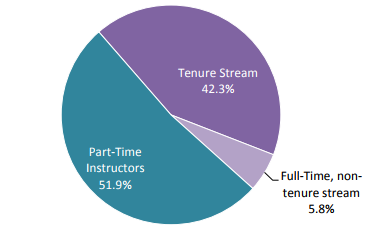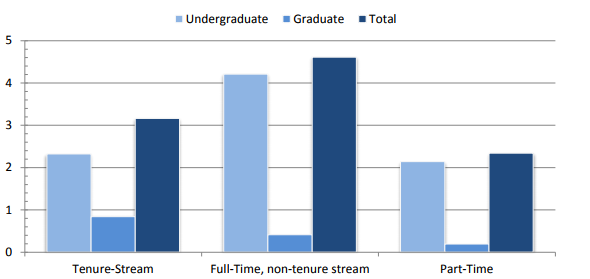Buckle up everyone. COU just did what universities have been telling everyone for years was impossible: publishing actual useful admin data on faculty workloads and sessionals from every university in Ontario bar the University of Toronto (speculate away as to why this is: the footnotes imply it’s because it couldn’t put together the data together properly).
It’s all right here. Read it. It’s the best data ever put together on Canadian faculty.
Oddly enough, COU published this yesterday with no fanfare at all. No tweets. No press releases that I have been able to find. I’m guessing this is because the data on faculty workloads is actually somewhat horrifying and institutions are not eager to see too much attention paid to it. So, let’s look at what the data actually says.
The first thing it does is actually quantify the data on staff numbers. Province-wide, minus U of T, tenure stream professors are a minority, which probably isn’t too surprising. But now at least we can all stop using those 75-80% estimates that we see from the US: the actual number is 42.3%
Figure 1: Full-time and Part-time Academic Staff
Now, as I pointed out back here when CCPA was talking loosely about college staff data, you can’t just leap from “50% of staff are sessionals” to “50% of all courses are taught by sessionals”. You need to know how many classes each teaches on average. And here is the slightly jaw-dropping data on that:
Figure 2: Average Annual Courses Taught
Apparently, the average course load across Ontario for tenure-stream faculty is 3.2. And that’s without U of T. Throw U of T in and it almost certainly drops below 3. And a quarter of that is teaching at the graduate level. So actually, only about 2.4 undergraduate courses per prof, per year, which is only slightly more than the average part-time (mainly sessional) prof teaches.
This is…kind of amazing.
What is even more amazing is that this is not, primarily, about course release. We are, of course, earnestly informed here that these numbers would be higher if it weren’t for things like academic and administrative course release. Apparently 40% of profs take some kind of leave of this nature and if you exclude them the number goes up to 3.5 courses – but of course if you do the math on that, it suggests that in fact the people who get course release are teaching below-average amounts of courses to begin with. What isn’t being reflected in the numbers, as far as I can tell, of course is sabbaticals and other forms of leave (e.g. mat leave). If you take people with those kinds of leave out of the denominator, the number for FT tenure-stream profs probably goes over 4 per term.
The payoff calculation in all this is the number of course-hours being taught by various types of staff. I’ll just quote from the report itself (note: the term “students” here refers to total course enrolments): 55% of courses and student enrolments are taught by full-time faculty members, who typically teach a much higher proportion of graduate level courses because of the specialized technical knowledge and strong research component of courses at the graduate level. (At the undergraduate level)…part-time instructors…teach 46% of students and 50% of courses.(emphasis added)
So in this instance, it turns out that sessionals do actually teach 50% of courses and almost 50% of students. And since sessionals, by definition, aren’t required to do research, it does make you wonder a bit why universities insist that they are so much better than other higher education institutions when it comes to research-informed learning if literally half of their teaching comes from non-researchers. One to think about.
The report also talks about tenure-track researchers’ research and service contributions. The almost meaningless figure of 2.3 research publications per prof per year is bandied about (note: this figure includes U of T and would almost certainly be lower if it were excluded as it is on the teaching side). More interesting is the data on service, which unfortunately is drawn from a much less representative 800 faculty members from six universities. According to this, 92% of faculty engage in one or more forms of service. But for the most part this consists of either participating in a departmental or faculty committee or disciplinary service (which presumably includes things like “reviewing a journal article”). Only 28% said they did “university service” and 24% said they did service to the community of some kind.
Unfortunately, neither the research nor the service data is linked to individual faculty files (though quite clearly it could be). What that means is we have no idea if those who teach more do less research/service than others or not. This is kind of important for public policy purposes: if we are only paying profs to teach 3.2 courses a year, we had better be getting our money’s worth in those other areas. But this is still a quibble: many kudos to COU for presenting the data in the first place.
Tomorrow: the data on sessionals. And boy is it interesting.



 Tweet this post
Tweet this post

Just one point about sessionals and research: certainly where I am (OCAD University), folks in the two labour categories not required to do research (sessional and teaching intensive) are in fact very active in scholarly activity or creative practice. I have no idea how widespread that is, but I do know that, at the annual conference of my professional association, sessional participate is high and growing, which suggests that the issue might be not so much that research isn’t happening, as it is that those folks aren’t getting paid for it.
(And the same is true of service, by the way: despite not getting paid for it, sessionals often find it hard to say no to committee work, partly because they want to stay in admin’s good books, but also because they know it’s good experience to have when job hunting.)
Yes, I agree. In my experience, both sessionals and teaching-stream faculty do as much research as anyone else; it’s just that they, and especially sessionals, don’t get recognized for their research or adequately supported in it.
Did you mean “4 per term” or “4 per year”? Former seems rather high to me actually, since most universities have a 2/2 teaching system (i.e. 2 per term).
I’m not sure all of this is that surprising really. The fact that TT faculty who don’t have admin leave teach 4 courses per year (which is the level most Ontario universities stipulate for TT faculty) is normal. Those who have admin leave would inevitably teach less.
Another question: does any of this separate out course directorships from tutorials? This is important if tutorials are included as sessionals are more likely to be teaching tutorials, while TT faculty direct/teach courses. It’s also important if tutorials are not included, since the amount of teaching sessionals do would then increase significantly.
The level of service activity is worrying, considering that universities are run on collegial governance – seems like only a minority of TT faculty are then involved in any way.
Kean (if I may),
I think there probably are a lot of profs skipping out on meetings and such, but I’d assume that only those with high responsibilities get course release.
What worries me more is that we seem unable to just automate or ignore unimportant things, and concentrate collegial decisions on setting policy, which the administration would then implement.
Now the interesting question: how much does it cost to deliver 50% of courses vs the other 50%…